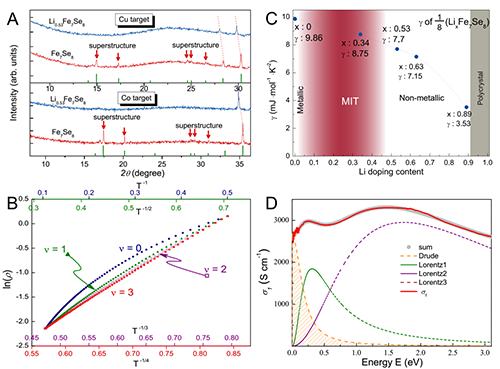Anderson localization of electrons in single crystal LixFe7Se8
Date:14-04-2016 Print
Originated from electron system, Anderson localization has been found highly relevant to wave phenomena and has been detected for photons, classical waves, matter waves and cold atoms. Disorder-induced metal-insulator transitions (MITs) have been intensively investigated in doped semiconductors such as Si:P. But their underlying working mechanism always entangles with electron correlation effects (Mott physics); they are therefore not ideal systems to investigate Anderson localization. A recent investigation on 3D polycrystalline semiconductor GeSb2Te4 revealed a MIT solely governed by disorder. 1 However, the small grain sizes (~10-20 nm) in GeSb2Te4 compounds complex the understanding of transport properties, and to synthesize disordered GeSb2Te4 single crystals is not yet feasible. Thus, to unambiguously determine the role of lattice disorder and electron localization experimentally is still being pursued. It is pressing to find a 3D single crystalline Anderson insulator, which might serve as a paradigm to study disordered electronic systems.
Recently, Prof. CHEN Xiaolong and coworkers from Beijing National Laboratory for Condensed Matter Physics, the Institute of Physics, Chinese Academy of Sciences report the discovery of LixFe7Se8, a breakthrough to produce single crystalline Anderson insulators. They found that by increasing Li doping, the superstructure peaks gradually disappear (Fig. 1A) and the structure is reduced to the fundamental NiAs structure. This result manifests that the disorder most likely originates from Fe sites. The 3D variable range hopping regime evidenced by electrical transport measurements at low temperatures (Fig. 1B) indicates the localized nature of the electronic states on the Fermi level. From specific heat and infrared reflectance measurements shown in Fig. 1C and 1D, they further observe the presence of considerable electronic states in the vicinity of the Fermi level when the MIT occurs, suggesting the transition is not due to Coulomb repulsion mechanism. Quantitative analyses of carrier concentration, carrier mobility and simulated density of states (DOS) fully support that LixFe7Se8 is an Anderson insulator. Therefore, it is the doping of Li that destroys the ordered arrangement of Fe vacancies in Fe7Se8, produces large amount of disorder, and finally results in electron localization at the EF. Based on these results, they provide a unified DOS picture to explain all the experimental results (Fig. 2), and a schematic diagram for finding other potential Anderson insulators (Fig. 3). This is the first report on Anderson localization of electrons in a 3D single crystal system. The discovery opens a new avenue to explore diverse aspects regarding disorder and MIT, and could enhance our understanding of electronic structure of materials.
The study entitled “Anderson localization of electrons in single crystals: LixFe7Se8” was published on Science Advances [Sci. Adv. 2, e1501283 (2016)].
This work is financially supported by the National Natural Science Foundation of China (grants 51532010, 51472266, 91422303, and 51202286), the Strategic Priority Research Program (B) of the Chinese Academy of Sciences (grant XDB07020100), and the International Centre for Diffraction Data.
1. T. Siegrist, P. Jost, H. Volker, M. Woda, P. Merkelbach, C. Schlockermann, M. Wuttig, Disorder-induced localization in crystalline phase-change materials. Nat. Mater. 10, 202-208 (2011).
Contact:
Institute of Physics
CHEN Xiaolong
Email:chenx29@iphy.ac.cn
Key word:
Anderson localization; metal-insulator transition; single crystal; lattice disorder;
Abstract:
Anderson localization, proposed more than half a century ago, has hardly been observed in 3D crystalline materials, let alone single crystals. Here, it is experimentally demonstrated that lattice disorder induced MIT transition can be realized in centimeter-size single crystals of LixFe7Se8. Quantitative analyses of carrier concentration, carrier mobility, and simulated density of states fully support that LixFe7Se8 is an Anderson insulator.
 |
| Figure 1. (A) Powder x-ray diffraction (XRD) of Li0.53Fe7Se8 and Fe7Se8 with both Cu and Co Kα radiations. (B) Plots of lnρ versus T−1/n+1 of Li0.89Fe7Se8 from 2 to 10 K. (C) Sommerfeld coefficients γ with different Li dopings. (D) The real part of optical conductivity spectrum for Li0.89Fe7Se8. |
 |
| Figure 2. Density of states evolution versus disorder diagram. In Fe7Se8 (left), EF cuts in the middle of the band; electrons stay itinerant near the EF. The doping of Li does not only slightly raise EF but also introduces disorder and leads to the appearance of a mobility edge EM, which separates localized areas (shaded region) and itinerant area part. When the EM shifts below EF (middle), MIT occurs. At higher lithium contents (right), VRH will become more prominent with the enhancement of disorder. |
 |
| Figure 3. carrier concentration versus disorder diagram. In the region with moderate n and high W, the probability to find Anderson localization is high. |

